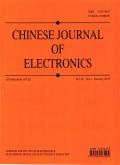基于特征模式的多端口天线在MIMO基站中的应用
IF 3
4区 计算机科学
Q3 ENGINEERING, ELECTRICAL & ELECTRONIC
引用次数: 0
摘要
基于特征模理论,研制了一种适用于4G/5G基站的新型多端口多输入多输出(MIMO)天线。计算结果表明,在1.7 ~ 2.7 GHz频段,适当设计的贴片可以同时激发5种模式。这些特征模态也为特征模态的进给位置选择和激励设计提供了明确的指导。特征模式的自然正交性保证了MIMO天线系统中多个端口之间的高隔离度。所研制的MIMO天线由两层结构组成。顶层为辐射孔径,底层为进料电路。研制的MIMO天线工作频带为1.64-2.74 GHz,可用于4G长期演进和sub-6 GHz 5G网络。利用TCM和特征模的正交性,设计了一种紧凑的四端口MIMO天线,其隔离度至少为20db。四个端口激发不同形状的辐射模式,具有不同的极化和辐射模式。四个端口之间的包络相关系数极低,这使得它对MIMO分集系统具有吸引力。仿真和实测结果都证明了所提出的设计。此外,还对遍历信道容量进行了评估,以证明在通信系统应用中的增强能力。本文章由计算机程序翻译,如有差异,请以英文原文为准。
A Characteristic Mode Based Multiport Antennas for MIMO Base Station Applications
A novel multiport multi-input multi-output (MIMO) antenna for 4G/5G base station application is developed based on the theory of characteristic modes (TCM). The solved characteristic modes illustrate that it is possible to excite five modes simultaneously with a properly designed patch in the 1.7-2.7 GHz frequency band. The characteristic modes also provide clear guidelines for selecting feeding places and designing excitation for the characteristic modes. The natural orthogonality property of characteristic modes guarantees high isolations among the many ports in a MIMO antenna system. The developed MIMO antenna is comprised of two layers. The top layer is the radiating aperture, while the bottom layer is the feeding circuit. The working frequency band of the developed MIMO antenna is 1.64-2.74 GHz, which can be used in 4G Long-Term Evolution and sub-6 GHz 5G networks. By using TCM and orthogonality of characteristic modes, a compact four-port MIMO antenna is designed with at least 20 dB isolations. The four ports excite different shapes of radiation patterns with diverse polarizations and radiation patterns. The envelope correlation coefficient is extremely low between the four ports, which makes it attractive for MIMO diversity systems. Both simulated and measured results are presented to demonstrate the proposed design. In addition, the ergodic channel capacity is also evaluated to demonstrate the enhanced capability in communication system applications.
求助全文
通过发布文献求助,成功后即可免费获取论文全文。
去求助
来源期刊

Chinese Journal of Electronics
工程技术-工程:电子与电气
CiteScore
3.70
自引率
16.70%
发文量
342
审稿时长
12.0 months
期刊介绍:
CJE focuses on the emerging fields of electronics, publishing innovative and transformative research papers. Most of the papers published in CJE are from universities and research institutes, presenting their innovative research results. Both theoretical and practical contributions are encouraged, and original research papers reporting novel solutions to the hot topics in electronics are strongly recommended.
 求助内容:
求助内容: 应助结果提醒方式:
应助结果提醒方式:


